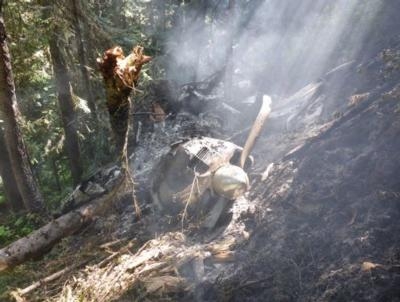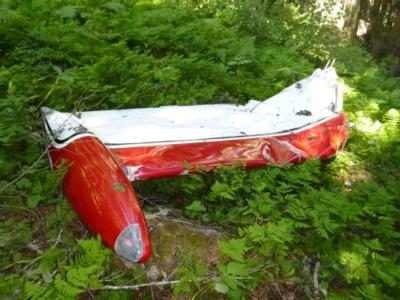Teenage Passengers Survived, Hiked Out Of The Mountains
The NTSB has released its probable cause report from an accident which occurred July 11th last year that fatally injured the pilot and passenger of a Beechcraft A35 airplane. A second passenger, the teenage stepdaughter of the pilot, survived the accident and was able to hike out of the mountains to get help.

The surviving passenger, then-16-year-old Autumn Veatch, stayed with the wreckage for a day before deciding to try to hike out of the mountains. After arriving at a road, she was picked up by a passing motorist and taken to a hospital, where she was treated for her injuries.
According to the factual report, on July 11, 2015, about 1600 Pacific daylight time, the Beechcraft A35, N8749A, was destroyed when it impacted terrain while maneuvering near Mazama, Washington. The private pilot and one passenger were fatally injured. The second passenger sustained serious injuries.
The airplane was registered to, and operated by, the pilot as a 14 Code of Federal Regulations (CFR) Part 91 personal flight. Visual meteorological conditions prevailed for the cross-country flight, and no flight plan had been filed. However, instrument meteorological conditions were reported near the accident site. The flight originated from Red Eagle Aviation (S27), Kalispell, Montana, about 1415 mountain daylight time, with an intended destination of Lynden Airport (38W), Lynden, Washington.
On July 11, 2015, an Alert Notification (ALNOT) was issued for the accident airplane. On July 13, 2015, a surviving passenger was located on Highway 20 near Easy Pass Head Trail, Skagit County, Washington. In a verbal statement provided to Okanogan County Sheriff's Department, she reported that she and her grandparents were flying from Montana. During the flight, the weather deteriorated, and the airplane flew into clouds. When the airplane exited the clouds, she saw a mountain in front of the airplane. The airplane impacted terrain, and a post-accident fire ensued. The surviving passenger attempted to extract the pilot and the other passenger from the wreckage, but she was unsuccessful. On July 14, 2015, the Skagit County Sheriff's Department located the wreckage about 16 miles west of Mazama.
A review of recorded communications between the pilot and a flight service station revealed that, before the flight, the noninstrument-rated, private pilot received two formal weather briefings. Both briefings reported that visual flight rules (VFR) conditions existed at the departure and destination airports but included forecast weather conditions along the route of flight that called for areas of mountain obscuration and precipitation. During the first briefing, the pilot disclosed that he had recently acquired a new tablet and that he was still learning how to use it. He also acknowledged that he would not be able to fly instrument flight rules if it became necessary.

The pilot postponed his departure after the first briefing, but he and two passengers departed for the cross-country personal flight under VFR about 2 hours after the second briefing. The surviving passenger reported that, about 1 1/2 hours into the flight, the cloud coverage increased and that the pilot started to descend the airplane to stay clear of clouds; however, the airplane entered a cloud. At that time, the other passenger was using the pilot’s tablet to help him navigate the airplane, but she accidentally turned it off. Shortly after, the surviving passenger observed trees directly in front of the windshield. The pilot pulled back on the yoke to try and gain altitude, but the airplane impacted mountainous terrain at an elevation of about 5,255 ft mean sea level.
The wreckage was confined to the impact area, and the damage was consistent with controlled flight into terrain. A postaccident examination of the airframe and engine revealed no evidence of preimpact mechanical malfunctions or failures that would have precluded normal operation. A review of satellite imagery indicated cloudy conditions over the accident location. Given the passenger’s statement, the flight likely encountered instrument meteorological conditions, and the pilot was unable to see the mountainous terrain until seconds before the collision.
The NTSB determined the probable cause of this accident to be the noninstrument-rated pilot’s decision to continue visual flight into instrument meteorological conditions, which resulted in his failure to maintain clearance from mountainous terrain.
(Source: NTSB. Images from NTSB accident docket)
 Aero-News: Quote of the Day (11.02.25)
Aero-News: Quote of the Day (11.02.25) ANN's Daily Aero-Term (11.02.25): Inner-Approach OFZ
ANN's Daily Aero-Term (11.02.25): Inner-Approach OFZ Classic Aero-TV: MultiGP Drone Racing - Aviations New Action Sport
Classic Aero-TV: MultiGP Drone Racing - Aviations New Action Sport ANN's Daily Aero-Term (11.03.25): On-Course Indication
ANN's Daily Aero-Term (11.03.25): On-Course Indication Airborne 10.29.25: X-59 Flies!!!, Kings Aid CFIs, Shutdown Hurts ATC Training
Airborne 10.29.25: X-59 Flies!!!, Kings Aid CFIs, Shutdown Hurts ATC Training




